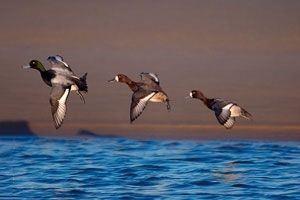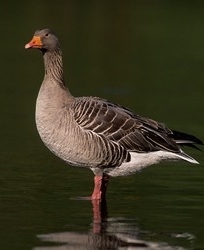Anseriformes
Migratory ducks and geese have long been a sporting quarry and in the past many were exploited on a commercial scale. However, the management of migratory species presents particular problems, as they often breed outside Britain and Europe. International cooperation across their entire migratory range is therefore essential for the conservation and management of their populations and habitats. This is provided under international law by the African-Eurasian Waterbird Agreement.
The Agreement allows for waterbird populations to be exploited on a sustainable basis. Wildfowl shooting can help to compensate farmers for the economic damage caused by some wintering flocks of these birds. Wildfowl shooting also provides an incentive to retain, create and improve breeding and wintering areas for waterbirds and other wetland species.
The Game & Wildlife Conservation Trust believes that, where possible, wildfowling should be allowed to continue and in some cases, where populations have recovered from low numbers, we believe that the shooting season of some species should be restored. We endorse the Codes of Practice developed for wildfowlers by the British Association for Shooting and Conservation.
Ducks
 The bulk of Britain's ducks breed in the far north, and western Europe serves mostly as a wintering area for these birds. In spite of the fact that agricultural land continues to be drained, and ditches and small wetlands continue to be lost, waterfowl as a group have generally fared well in western Europe since the Second World War.
The bulk of Britain's ducks breed in the far north, and western Europe serves mostly as a wintering area for these birds. In spite of the fact that agricultural land continues to be drained, and ditches and small wetlands continue to be lost, waterfowl as a group have generally fared well in western Europe since the Second World War.
Gravel workings and reservoirs have helped to compensate for the wetland loss and, although there have been shifts in the numbers and range of some species, none has experienced a decline severe enough to cause real concern.
Management of a group like the ducks is inherently more difficult than the management of gamebirds. Since most species except mallard are migratory, the birds that breed on a landowner's waters in spring and summer and those that are resident in winter during the shooting season are unlikely to be the same. Thus it is entirely appropriate that ducks as a group need to be monitored and conserved on a regional and international basis. Nevertheless, owners of wetlands, whether they be private individuals, companies or public bodies, ultimately bear the responsibility for providing the right habitats for waterfowl.
Geese and swans
 Over the last 40 years geese and swans have flourished and some population increases have been enormous. This includes species such as the native brent, as well as the non-native Canada goose. There are many reasons for this, but species protection and agricultural change are probably the main ones.
Over the last 40 years geese and swans have flourished and some population increases have been enormous. This includes species such as the native brent, as well as the non-native Canada goose. There are many reasons for this, but species protection and agricultural change are probably the main ones.
The conservation and sporting organisations of the 1950s (then the Nature Conservancy, the Wildfowl Trust and the Wildfowlers' Association of Great Britain and Ireland) can take a large measure of the credit for the successful outcome of their joint conservation efforts, as well as for establishing an increasingly comprehensive counting scheme for monitoring winter numbers.